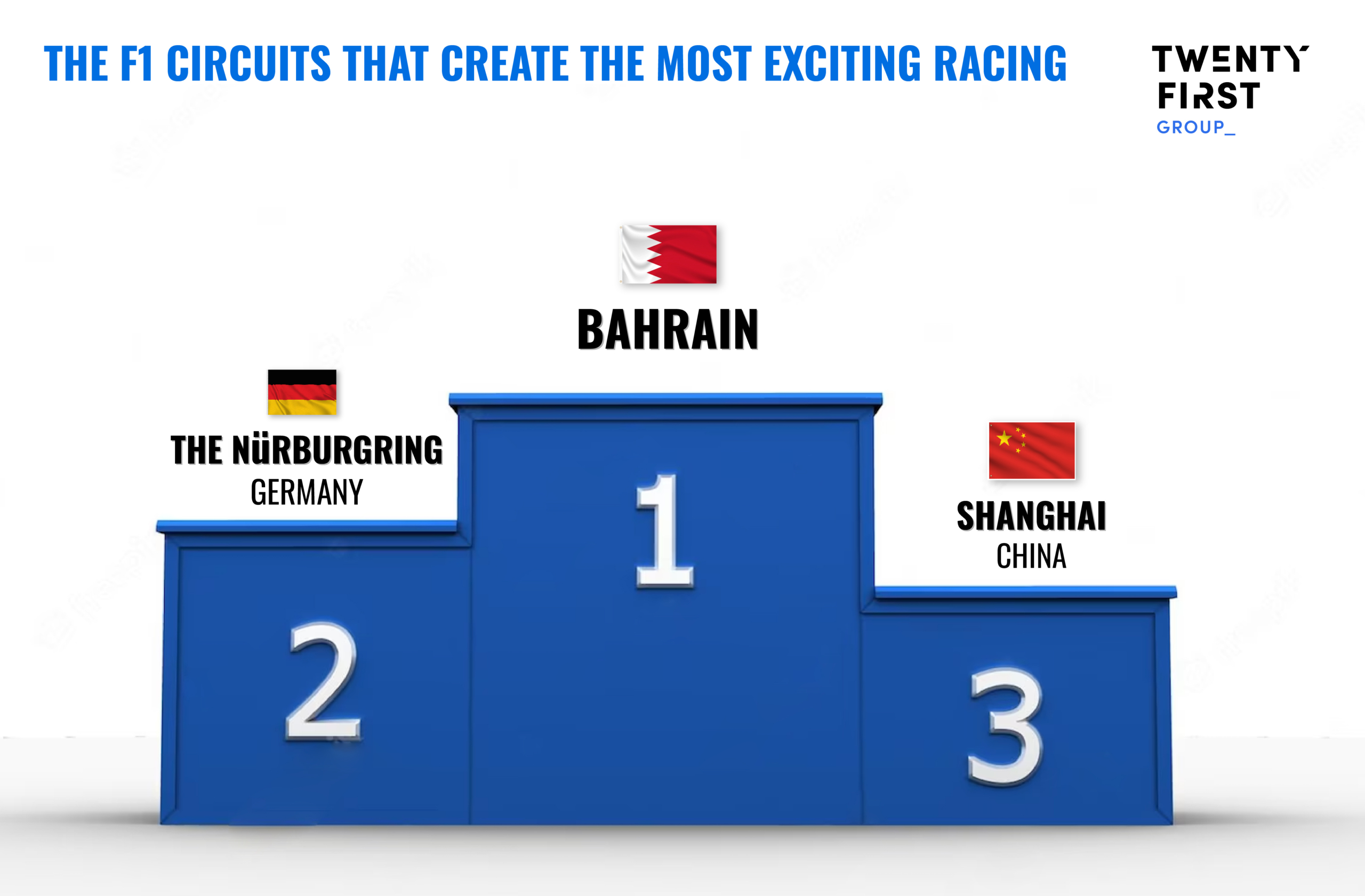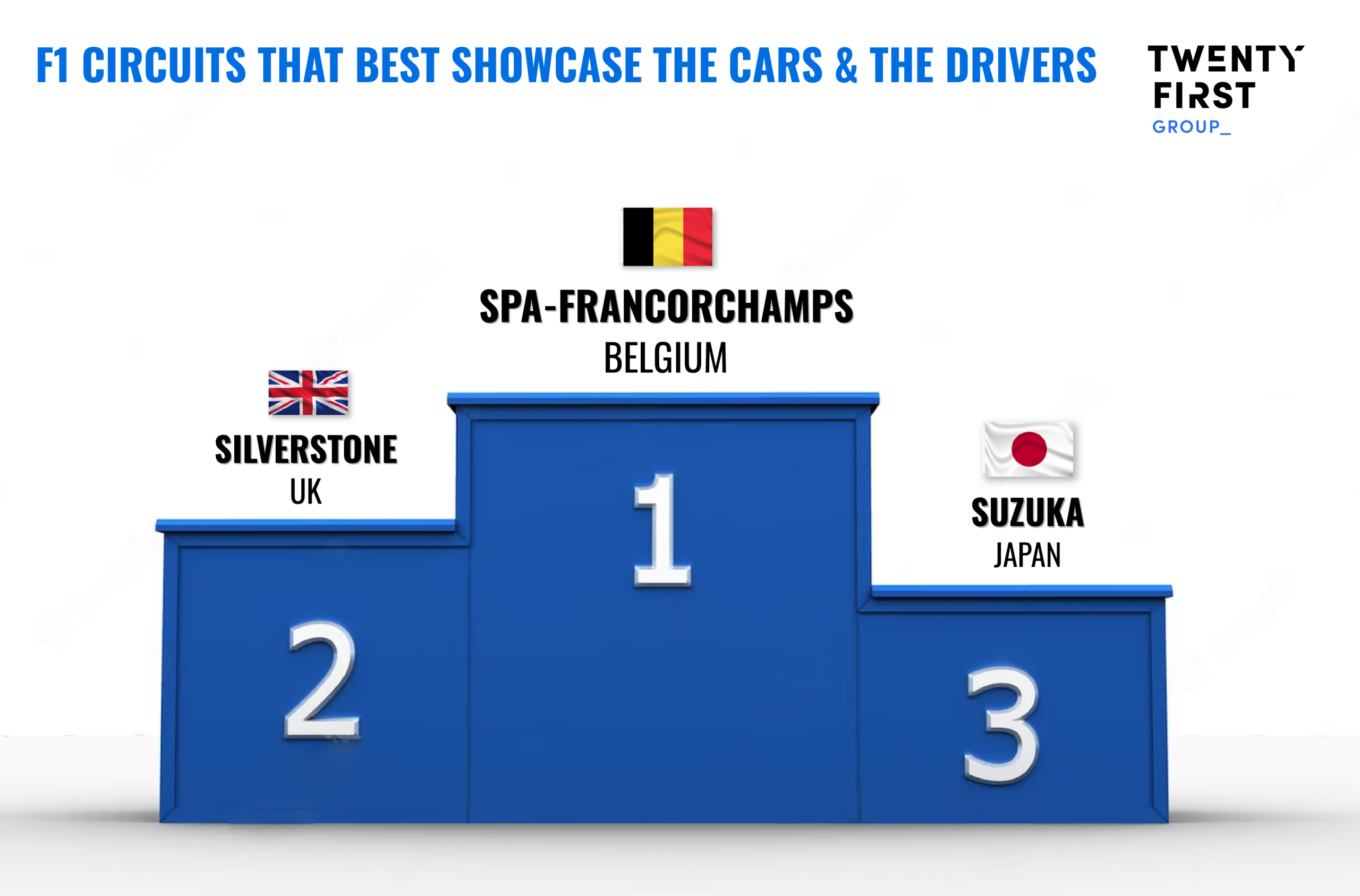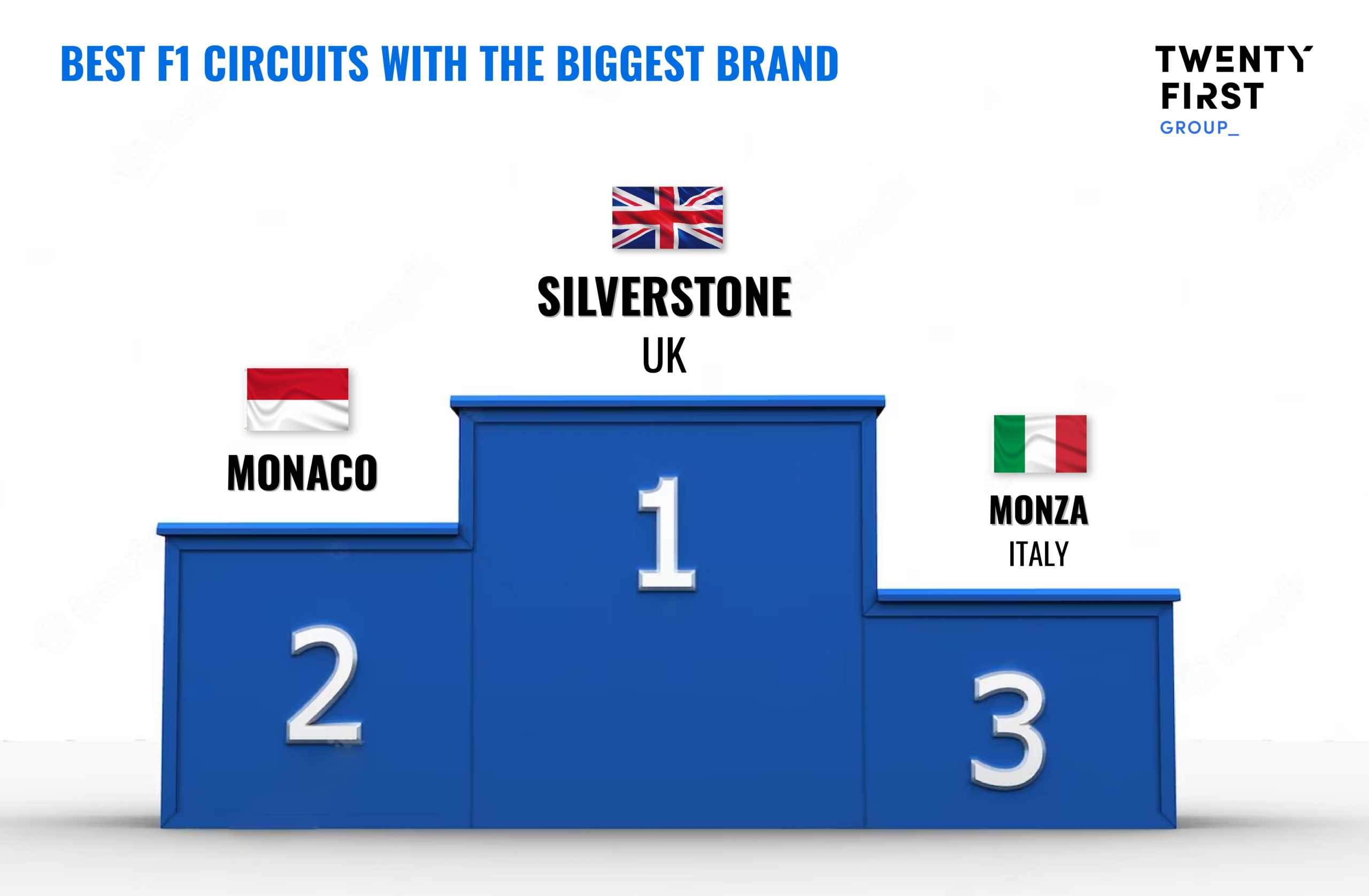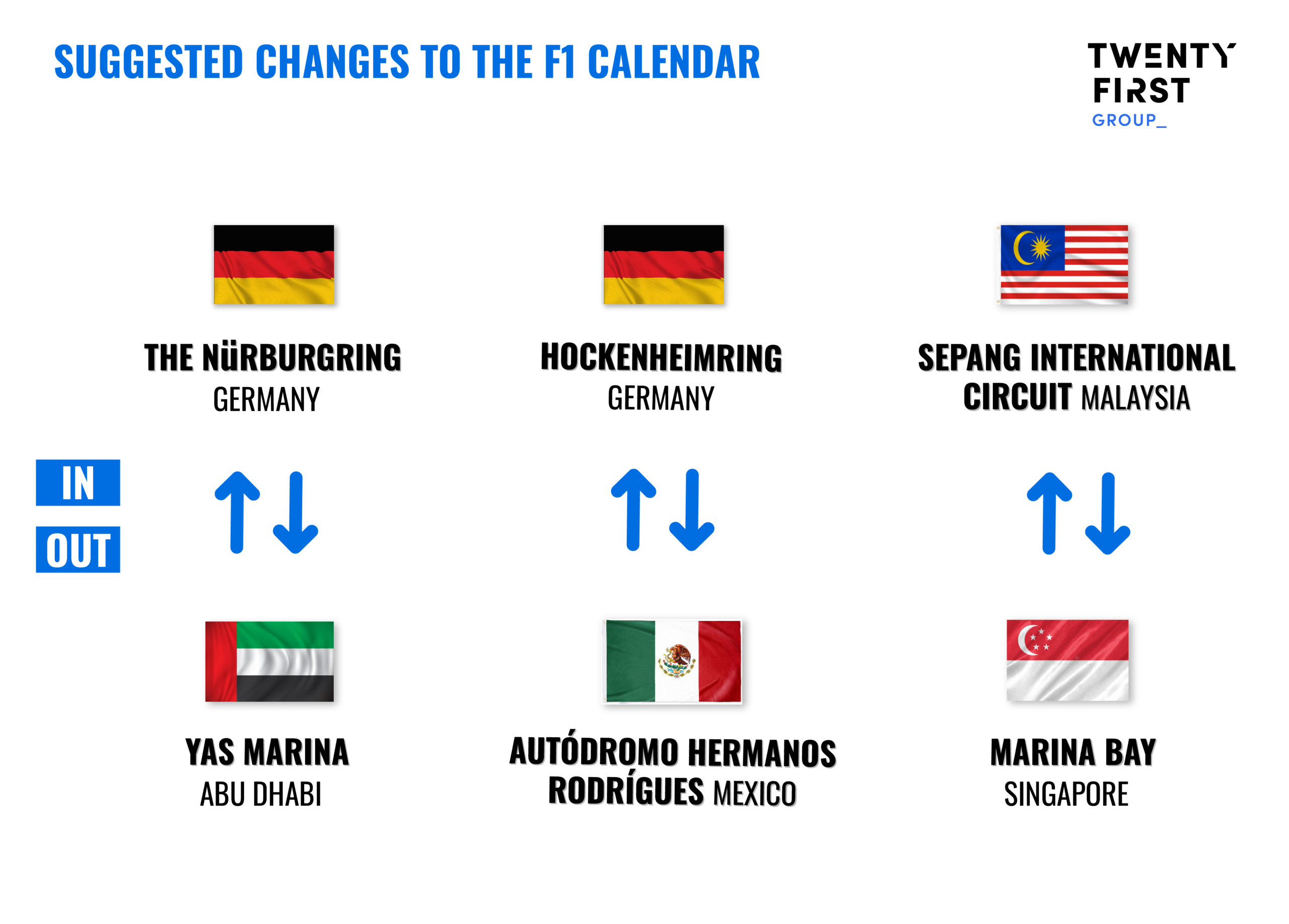Thought Leadership
How F1 can select the best circuits to maximise its appeal
13 MIN READ
Thought Leadership
Inspired by what you’re reading? Why not subscribe for regular insights delivered straight to your inbox.
In our previous article on Formula 1, we referenced the different levers the sport can use to elevate its product. Most recent discussions on how the sport can encourage exciting and competitive racing have focussed on the regulation changes that kicked in at the start of last season, perhaps without the desired effect so far. In this article, we focus on another crucial lever for the sport: the choice of circuits on the calendar.
We’ve used data to look at which tracks produce the best racing, which tracks have the highest brand value, and which tracks currently missing from the calendar have a case to be there. Through promoting higher quality racing and increasing jeopardy on race days, Formula 1 can further elevate its sporting product.
We’ve evaluated circuits against both brand and sporting metrics:
- Brand: which tracks have the biggest name recognition and following, have a long history with F1, and are associated with the largest potential audience.
- Exciting racing: which tracks are best for compelling racing, with lots of overtaking and changes in position on race day.
- Showcasing cars and drivers: circuits that showcase Formula 1’s cars and drivers at their best through variety in track layout, lots of fast corners and high-speed straights.
- Unlikely outcomes: which tracks are most likely to lead to unexpected outcomes, with drivers lower down the season standings pulling off shock results.
According to our Intelligence Engine the top three circuits overall are Spa-Francorchamps (Belgium), Silverstone (UK) and the Nürburgring (Germany).
The first two in our rankings are both historic tracks and have hosted over 100 Formula 1 races between them, so perhaps it is no surprise that these mainstays of the calendar score well across most categories. They rank particularly highly on our “Showcasing cars and drivers” metric. Notably, these tracks boast some of the fastest corners on the calendar and rank among the top five in terms of average speed. Spa, in particular, scored highest overall for the variety of challenges it presents to drivers, with Eau Rouge being one of the most iconic sections of track in motorsport.
The Nürburgring (Germany) completes our top three but despite having a long history with the sport, it last hosted a Formula 1 race in 2020. It is our highest rated circuit to not feature on the current calendar.
Interestingly, possibly the most iconic track in Formula 1 is missing from the top three: Monaco. Monaco has one of the highest brand values in our scoring but it falls down on our sporting measures. It is a notoriously challenging track and the tight streets of Monte Carlo combined with the increased size of Formula 1 cars have made overtaking very difficult. It is therefore our lowest-rated circuit for exciting racing.
The track does have the capacity to deliver unlikely outcomes however, thanks to its high penalty for mistakes: once you’ve made an error, you’re unlikely to be able to regain your position or may even be out of the race entirely. In general, tracks with a higher dropout rate tend to be more likely to throw up unexpected results. A circuit’s propensity for overtakes on the other hand is far less correlated with getting unlikely race winners or podium finishers.
EXCITING RACING
This season’s opening circuit, Bahrain, features at the top of the “Exciting racing” index thanks to the relative ease of overtaking there: only Spa-Francorchamps features higher in our overtake propensity model. This helps to deliver exciting racing for fans, with the average number of times the podium positions change during races the highest in Bahrain.
Second and third place in this category go to the Nürburgring (Germany) and Shanghai (China).
SHOWCASING F1 CARS AND DRIVERS
Spa-Francorchamps and Silverstone are 1st and 2rd in this category respectively with Suzuka (Japan) completing the top three. These circuits are all fast, feature high-speed corners and present a variety of challenges to drivers.
Another of Formula 1’s most iconic circuits narrowly misses out on the top three in this category, but Monza still rates very highly overall (5th) thanks in part to its excellent score here. It has the highest average speed of any circuit.
UNLIKELY RESULTS
Our previous article showed that seasons with a relatively uncontested champion tend to turn fans away. The sport has often suffered from this excessive predictability: the top three finishers in the Drivers Championship win almost 90% of races on average based on data from the past 10 seasons. For this reason, one of the metrics we’ve rated circuits on is how often races at that track delivered unexpected outcomes.
Top of the rankings in this category was Circuit Gilles Villeneuve (Canada). Not unrelatedly, the final turn is named the “Wall of Champions” for the frequency with which even the best drivers have crashed into it. As noted above, higher track difficulty is correlated with a greater chance of an unlikely winner or podium finisher. Second and third place for this metric went to Albert Park (Australia) and Monaco.
BRAND
Silverstone, Monza and Monaco are the tracks that rated highest on our brand metric, and are amongst the most iconic tracks in the sport. But which other tracks scored highly?
Circuit of the Americas (COTA) ranks 4th overall thanks to the USA being the biggest potential growth market for Formula 1. Despite lower relative interest in the sport compared to its traditional European base, the US boasts a population larger than the combined total of the top ten countries with the highest relative interest in F1, so there remains significant untapped potential.
A second US race was added to the calendar last year alongside COTA: Miami is not included in our sporting rankings as we have minimal data on the circuit so far, but it would have come out ahead of COTA and just behind Monza had we included it in our brand rankings. Search interest in the race last year was very high and the Miami Grand Prix Instagram account has so far accumulated ~200k followers.
The final track in the top five of the brand rankings was Mexico City. Mexico is one of the highest scoring countries outside of Europe for interest in Formula 1. The Autódromo Hermanos Rodríguez has the highest number of Instagram followers of any circuit currently on the calendar and the home fans generate a fantastic atmosphere while supporting Mexican driver Sergio Perez. The circuit scores very poorly across our sporting metrics however, leaving it close to the back of the grid in the overall rankings.
Additions to the calendar
If Formula 1 wants to add more countries to the schedule to draw in extra fans, Germany, South Africa and Indonesia are the three countries currently absent from the calendar that come out highest in our ranking of potential fan markets. Two German circuits feature in the top ten of our rankings: the Nürburgring and the Hockenheimring.
Aside from these two, the other highly-rated circuit currently missing from the calendar is the Sepang Street Circuit in Malaysia, with the track scoring particularly highly on our “Exciting racing” and “Unlikely outcomes” metrics.
Recommended changes for an Optimum Race Calendar
Based on the above criteria these are the three circuits we’d recommend adding back into the race calendar and the three lowest-scoring circuits we’d recommend taking out to make space for them:
By switching out the three lowest ranked circuits based on the criteria outlined in this article, Formula 1 could create more exciting racing across the whole season and improve the appeal of it’s sporting product. With an increasingly packed schedule and a growing fanbase in new markets, there is more competition for spots on the F1 calendar than ever before. Selecting the right circuits gives F1 an additional means by which to grow its sporting and commercial product through promoting high quality racing, increasing jeopardy, and creating connection with new fans.
For more information about our Competition Intelligence services please get in touch with Ben Marlow.












